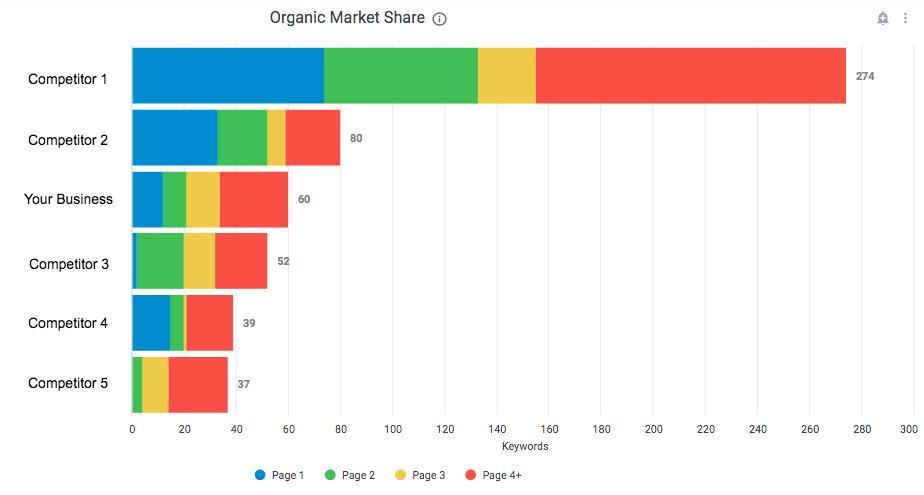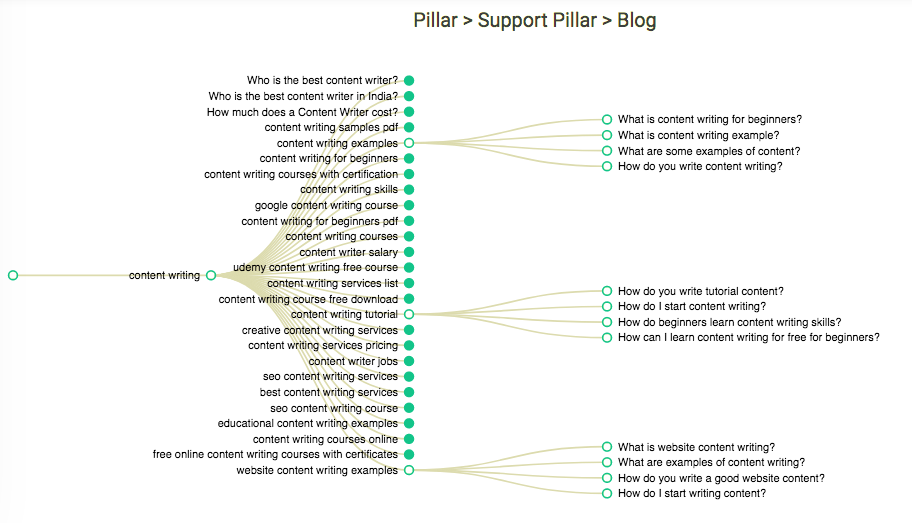PBM—the latest tech acronym taking over the marketing world. Pillar-Based Marketing (PBM) is all about creating the exact content your audience needs to drive your business outcomes. Let’s talk about how you can achieve these results and how DemandJump, the company behind the world’s first PBM platform, helps get you there.
What Does PBM Mean in Marketing?
Pillar-Based Marketing is a proven content marketing strategy that empowers businesses to climb search engine result pages (SERPs). How does it work? The foundation of a PBM strategy is built around a network of keyword-oriented topics that all relate to a central subject or question, one that the business would benefit from being seen as an authority on. The three types of content that create this infrastructure are:
- The Pillar Page - A pillar page should cover a broad topic in 3,000+ words. For example, let’s say you’d like to show up as a result for people researching “content writing.” Your pillar page title could simply be just that—“Content Writing.” Add in at least 15-20 high value keywords, let those keywords guide your writing, and eventually you’ll have yourself a pillar page.
- Sub-Pillars - Your sub-pillars should delve into slightly more specific topics that fall under the pillar page umbrella. These are 2,000+ word pieces with around 15 keywords, and you should plan for at least three sub-pillars per pillar page. An example of a “Content Writing” sub-pillar might be “Content Writing for Beginners” or “Website Content Writing Examples.”
- Supporting Blogs - These are the shortest type of PBM content (around 750-1,000 words with 7-8 keywords), but they cover the most detailed topics and keyword questions that relate to the pillar. Each pillar and sub-pillar page should have three supporting blogs associated with it, for a total of 12 supporting blogs for each pillar plan you develop. An example of a supporting blog topic for the “Content Writing” pillar would be “What Are Examples of Content Writing?” or “How Do I Start Content Writing?”
Each piece of content is linked together through a specific hyperlinking structure, with the sub-pillars linking to the pillar page, and each supporting blog linking to its related sub-pillar and the pillar.
 What Are PBM Platforms?
What Are PBM Platforms?
A PBM platform is technology that allows you to harness the power of Pillar-Based Marketing. Currently, DemandJump is the only PBM platform available on the market, so you won’t find any PBM platform comparisons out there just yet. We’ve gone above and beyond to offer you a wide variety of features in our platform, like:
- Overviews of your current search engine rankings on any topic you choose
- Insights on where your competitors fall in those same search engine rankings
- Auto-generated lists of keywords to focus on for any topic you choose
- Recommendations on content you can create or improve to move up the SERPs
- Management capabilities to organize your pillar, sub-pillar, and supporting blog topics
- Analytics for organic search, social media, and more
What Are PBM Tools in Marketing?
Whatever PBM tools you use for pillar strategy, they should at minimum factor in solutions for keyword research and discovery, as well as pillar plan management. For a more specific picture of how a PBM company works, let’s take a look at the top PBM tools and their uses within the DemandJump platform.
Research Discovery
Before you begin writing your pillar pages, sub-pillars, and supporting blogs, you first need to do your research and discover what your customers are searching for. A great place to start is by running an automated Insight Report on DemandJump. Simply type in a phrase you would like to rank number one for on search engines, and our platform will do the rest of the research for you.
If you would like to do a more advanced search for your Insight Report, you can also include the domains of your competitors. With this information, your generated Insight Report will include an Organic Market Share graph. The details of this graph will show:
- A list of any competitors that you add to your account
- The number of keywords you and your competitors are ranking for on SERPs
- Where your ranking keywords fall on SERPs (page one, two, three, or four and beyond)
For example, you might find your Organic Market Share looks something like this:

With this information, you have transparency as to where you stand when people search for topics related to your business. In the above example, you can see you’re currently ranking for about 60 keywords. And by clicking on each of the page-related colors, you can pull up a list of the exact keywords falling on that SERP. We also provide you with other eye-openers to discover, like:
- The estimated search volume for any keyword or phrase
- Our DemandJump Score, which is a 1-100 rank score signifying the power of a phrase or question within that topic network
- The exact position you are in for any keyword on SERPs
By leveraging this knowledge, you can pinpoint the exact areas to write about in order to take a share of the market.
Besides the Organic Market Share graph, your Insight Report will also include the top 25 keywords and questions that relate to your main topic. Within these lists you’ll find the priority of each keyword and where you currently rank for that keyword. This will inspire topic choices for your business’s unique PBM strategy.
And like any good marketing strategy, PBM requires monitoring and upkeep. Your competitors are out there writing about the same things you are. To stay on top, you can revisit the Insight Report at any time to get suggestions for improving your results. We even show you which pieces of your content aren’t ranking as well as they could so you know exactly which content to upgrade and refresh.
Managing Pillar Topics
Once you’ve done your research, the brainstorming and writing can begin! From your DemandJump Insight Report, you can easily pull topics for your pillars, sub-pillars, and supporting blogs.
Visualizing a pillar plan within the DemandJump platform is easy with the interactive Pillar Strategy flowchart. It offers you suggestions for sub-pillar and supporting blog topics based on your chosen pillar subject. Simply select the topics you’d like to write about, and you’ll have an entire pillar plan in a matter of minutes. Here’s what a flowchart for “Content Writing” might look like:

You could certainly do all this research on your own without pillar-based sales tools, but it requires a series of long and tricky processes—and you might be relying on guesswork at times. Why not accomplish the same thing with only a few clicks in a fraction of the time? The PBM technology to do this is here, waiting to take your business to new heights.
What Are the Best Qualities of PBM Technology?
The best qualities of PBM technology are the opportunities to add human value back into the fast-paced world of marketing. Yes, PBM centers around keywords, but it’s come a long way from the shady keyword stuffing techniques of early SEO strategies. Modern search engine algorithms are far too intelligent for those tactics. Today, it’s more about identifying the exact questions your audience has, and then answering those questions in an intelligent and helpful way.
Think about the last thing you researched on Google. What did some of your search queries look like? For example, let’s say you run a nonprofit that focuses on after-school tutoring for low-income families, and you’re looking for your first CRM (customer relationship management) platform to make your work life a little more streamlined.
Perhaps you start with a simple search term,“CRM.” But after seeing that come back with over three billion results, you decide to narrow your search a bit. Next, you try “nonprofit CRM,” but that still has millions of results to sift through—and all of them seem rather generic. So you narrow your search even further and try, “What is the best CRM for nonprofits in education?”
Now the results are serving you what you need! Maybe you find articles about the top 10 CRMs for education-focused nonprofits, or side-by-side comparisons of those same platforms. By making your query more specific, the search engine algorithms were able to lead you to the exact information you needed.
This is how people are searching the internet. And the more it works, the longer and more specific our search phrases will get. By utilizing the power of Pillar-Based Marketing, you can discover the exact content to create to answer these questions, no matter how long or short they may be. And by offering helpful advice and establishing yourself as an authority on a topic, you’ll soon see an increase in first page rankings and be one step closer to achieving desired outcomes for your business.
What Companies Use PBM?
Although Pillar-Based Marketing is a relatively new strategy in the marketing world, it has already brought success to many different companies. And the great thing about PBM is that it works for virtually any business, no matter the industry.
We’ve seen B2B companies, like Collective[i] and Oracle, find great success with PBM. If your business is more B2C, PBM can help there as well! Some of our latest B2C customers sell products like planters (ePlanters), outdoor cooking equipment (Camp Chef), and curated sneaker collections (snkrbox).
This is just a handful of the businesses using PBM to boost their content marketing strategy. If you’d like to hear more about how these companies harnessed the power of PBM, check out our Page One or Bust! podcast.
In the podcast, we recently interviewed Stephen Messer—Co-Founder of Collective[i]—about how Collective[i] disrupted the sales forecasting game with a Pillar-Based Marketing strategy that built strong brand awareness and generated an impressive volume of leads. We also had a great conversation with Nick Wojdyla— Director of Digital Marketing and Communications at Cummins—about picking the best SEO tools, creating a data management plan, and keeping your transformation affordable.
We hope that by sharing the wisdom of these companies and how they use PBM, you too can empower your business through this proven marketing strategy.
Is PBM Successful?
Yes, PBM works! We may be a little biased, but it’s been working for us. It got you to this blog, didn’t it? But we get it, you need some Pillar-Based Marketing examples and proof! Check out this use case of one of our customers, Camp Chef.
Camp Chef has been in business for over 20 years, producing high quality products that offer efficient ways to cook for almost any outdoor gathering. They saw a common pain point amongst campers and outdoor enthusiasts—a love for cooking, but a lack of quality cooking equipment designed specifically for the outdoors. Camp Chef now offers thousands of solutions for outdoor cooking, from campouts in the wilderness to campouts in your backyard.
In 2017, Camp Chef geared up to go all in on a robust eCommerce strategy. They decided to use a PBM vendor for their organic marketing needs—enter, DemandJump! By using the DemandJump platform, Camp Chef saw a 268% increase in revenue and a 242% increase in return on ad spend.
How did this happen? We boosted their paid search strategy, capitalizing on in-market consumers with high purchase intent. Via our platform, we analyzed tens of thousands of unique search queries that were delivering results for competitors. We then used those insights to rebuild Camp Chef’s paid search structure around clusters of popular search terms that were sure to have a substantial impact on conversion.
Based on this new keyword strategy, Camp Chef launched over two dozen paid search campaigns, and within only 90 days they experienced a 25% increase in overall traffic to their website from this channel. The numbers started to climb, eventually leading to the 268% increase in revenue and a 242% increase in return on ad spend.
Maybe at this point we’ve convinced you of the power of PBM, but you still have one question nagging at the back of your mind—how much is this going to cost me?
Does PBM Cost Money?
That’s the great thing about PBM—it doesn’t have to cost you a dime! You can start using the DemandJump PBM platform today for free. Plus, we offer an entire Pillar-Based Marketing course to get you started if you’re new to PBM. Simply sign up for a free account, and you can access the entire PBM marketing course through DemandJump University.
If you’d like to upgrade your PBM experience, we do offer paid plans that include additional features, like ad integration, additional competitor insights, and more. Check out our pricing plan options here.
What Are PBM Techniques That Work Best?
The best technique for developing your own PBM strategy is to use DemandJump. It’s as simple as that. Sure, you can spend hours gathering your own keyword research and studying your competitors—but why do that when we can do it for you? And for free?
Think of all the things you can do with the extra time you save! You can work on cultivating other business growth strategies, go on that vacation you’ve been putting off, or finally get in that well-deserved nap.
Ready to get this time back and achieve all those outcomes you’ve been working so hard for? Give Pillar-Based Marketing a try!











 What Are PBM Platforms?
What Are PBM Platforms?
